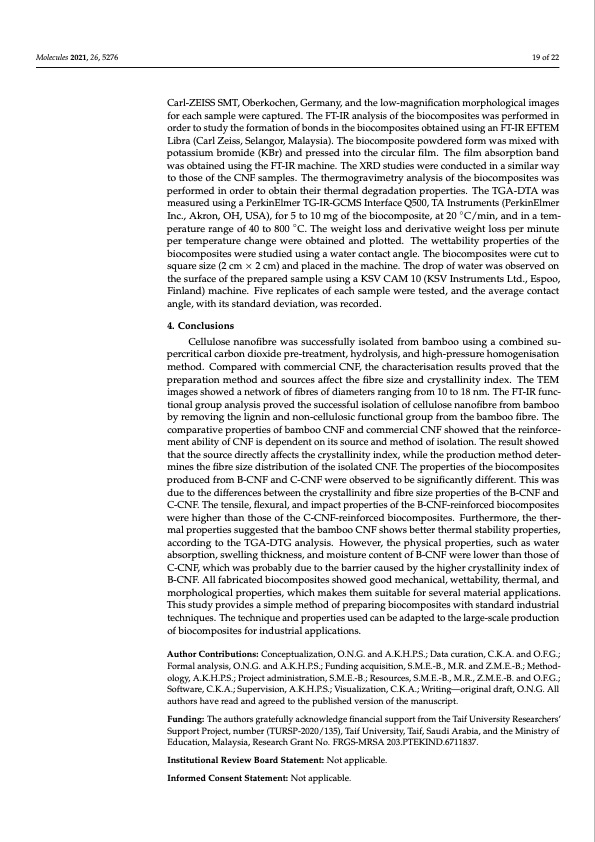
PDF Publication Title:
Text from PDF Page: 019
Molecules 2021, 26, 5276 19 of 22 Carl-ZEISS SMT, Oberkochen, Germany, and the low-magnification morphological images for each sample were captured. The FT-IR analysis of the biocomposites was performed in order to study the formation of bonds in the biocomposites obtained using an FT-IR EFTEM Libra (Carl Zeiss, Selangor, Malaysia). The biocomposite powdered form was mixed with potassium bromide (KBr) and pressed into the circular film. The film absorption band was obtained using the FT-IR machine. The XRD studies were conducted in a similar way to those of the CNF samples. The thermogravimetry analysis of the biocomposites was performed in order to obtain their thermal degradation properties. The TGA-DTA was measured using a PerkinElmer TG-IR-GCMS Interface Q500, TA Instruments (PerkinElmer Inc., Akron, OH, USA), for 5 to 10 mg of the biocomposite, at 20 ◦C/min, and in a tem- perature range of 40 to 800 ◦C. The weight loss and derivative weight loss per minute per temperature change were obtained and plotted. The wettability properties of the biocomposites were studied using a water contact angle. The biocomposites were cut to square size (2 cm × 2 cm) and placed in the machine. The drop of water was observed on the surface of the prepared sample using a KSV CAM 10 (KSV Instruments Ltd., Espoo, Finland) machine. Five replicates of each sample were tested, and the average contact angle, with its standard deviation, was recorded. 4. Conclusions Cellulose nanofibre was successfully isolated from bamboo using a combined su- percritical carbon dioxide pre-treatment, hydrolysis, and high-pressure homogenisation method. Compared with commercial CNF, the characterisation results proved that the preparation method and sources affect the fibre size and crystallinity index. The TEM images showed a network of fibres of diameters ranging from 10 to 18 nm. The FT-IR func- tional group analysis proved the successful isolation of cellulose nanofibre from bamboo by removing the lignin and non-cellulosic functional group from the bamboo fibre. The comparative properties of bamboo CNF and commercial CNF showed that the reinforce- ment ability of CNF is dependent on its source and method of isolation. The result showed that the source directly affects the crystallinity index, while the production method deter- mines the fibre size distribution of the isolated CNF. The properties of the biocomposites produced from B-CNF and C-CNF were observed to be significantly different. This was due to the differences between the crystallinity and fibre size properties of the B-CNF and C-CNF. The tensile, flexural, and impact properties of the B-CNF-reinforced biocomposites were higher than those of the C-CNF-reinforced biocomposites. Furthermore, the ther- mal properties suggested that the bamboo CNF shows better thermal stability properties, according to the TGA-DTG analysis. However, the physical properties, such as water absorption, swelling thickness, and moisture content of B-CNF were lower than those of C-CNF, which was probably due to the barrier caused by the higher crystallinity index of B-CNF. All fabricated biocomposites showed good mechanical, wettability, thermal, and morphological properties, which makes them suitable for several material applications. This study provides a simple method of preparing biocomposites with standard industrial techniques. The technique and properties used can be adapted to the large-scale production of biocomposites for industrial applications. Author Contributions: Conceptualization, O.N.G. and A.K.H.P.S.; Data curation, C.K.A. and O.F.G.; Formal analysis, O.N.G. and A.K.H.P.S.; Funding acquisition, S.M.E.-B., M.R. and Z.M.E.-B.; Method- ology, A.K.H.P.S.; Project administration, S.M.E.-B.; Resources, S.M.E.-B., M.R., Z.M.E.-B. and O.F.G.; Software, C.K.A.; Supervision, A.K.H.P.S.; Visualization, C.K.A.; Writing—original draft, O.N.G. All authors have read and agreed to the published version of the manuscript. Funding: The authors gratefully acknowledge financial support from the Taif University Researchers’ Support Project, number (TURSP-2020/135), Taif University, Taif, Saudi Arabia, and the Ministry of Education, Malaysia, Research Grant No. FRGS-MRSA 203.PTEKIND.6711837. Institutional Review Board Statement: Not applicable. Informed Consent Statement: Not applicable.PDF Image | Supercritical Carbon Dioxide Isolation of Cellulose Nanofibre

PDF Search Title:
Supercritical Carbon Dioxide Isolation of Cellulose NanofibreOriginal File Name Searched:
molecules-26-05276-v2.pdfDIY PDF Search: Google It | Yahoo | Bing
Sulfur Deposition on Carbon Nanofibers using Supercritical CO2 Sulfur Deposition on Carbon Nanofibers using Supercritical CO2. Gamma sulfur also known as mother of pearl sulfur and nacreous sulfur... More Info
CO2 Organic Rankine Cycle Experimenter Platform The supercritical CO2 phase change system is both a heat pump and organic rankine cycle which can be used for those purposes and as a supercritical extractor for advanced subcritical and supercritical extraction technology. Uses include producing nanoparticles, precious metal CO2 extraction, lithium battery recycling, and other applications... More Info
| CONTACT TEL: 608-238-6001 Email: greg@infinityturbine.com | RSS | AMP |